by Winding Pathways | Nov 4, 2021 | Birds, Nature
What is a Bird Diva?
We’d only walked a short way when Bridget Butler stopped our small group. “Look at the top of that tree. See the bird,” she asked.
We did, and from long experience knew its species, but Bridget’s coaching helped us become better birders.
“Notice its size. Is it bigger/smaller than a sparrow”? (Bigger). Colors? (reddish/brownish).
Bridget was teaching us her method of slow birding. It’s an effective way to spot birds and figure out the species.
Slow Birding
We were in Vermont to attend the conference of the Outdoor Writer’s Association of America at Jay Peak ski resort tucked up near Canada. The Peak’s ashes, maples, and aspens were in glorious full color on the early October morning. Up early, we had met Bridget and other conference attendees in the hotel lobby.
Bridget slowly led us just past the parking lot, eyes and ears open for the slightest movement or chirp. We spotted and heard birds that a hasty walk would have bypassed.
What to Look and Listen For
Bridget’s suggestions for identifying a bird include:
Listen carefully. Often, it’s easier to distinguish a species by sound rather than sight. Close your eyes to help focus on sound.
Observe size. Compare the bird to common, landmark species. Is the bird bigger /smaller than a sparrow or robin or crow, for example?
Observe color/Patterns. Where is the most color on the bird? Are there eyelines, streaking on the breast?
Observe activity. Is the bird perched high in a tree or scurrying around in bushes? Is it solitary or in a flock?
Observe the habitat. Coniferous woods, hardwood forest, brush, grassy, marsh.
The bird we first spotted high in a spruce tree was a common American Robin, one of the most visible and recognizable of all birds. It provided Bridget with an example of how to help birding newcomers to learn species. And, was a reminder to experienced birders to slow down and observe more and be concerned less with adding to “the list.”
Various Habitats
Our walk took us from a mowed lawn through a dense sugar maple wood and around to a delightful pond at Jay Peak’s base. While in the woods a barred owl responded to Bridget’s call.
When we emerged from the woods to the open pond, we spotted a knot of ducks swimming on the far end. “Let’s walk slowly and see how close we can get,” she said. She suggested we avoid looking directly at the ducks – pretending that we didn’t know they were there. It worked! The ducks seemed unconcerned about our slow pace toward them yet instantly took flight when a jogger appeared on the other side of the pond.
Ring-Billed ducks! A thrilling sight as the colorful and agile birds winged against the backdrop of Jay Peak’s autumn splendor.
-
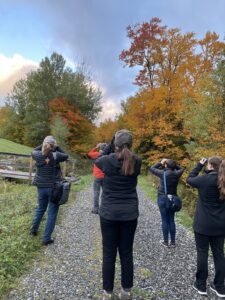
-
Pause to listen and look. Binoculars help.
-
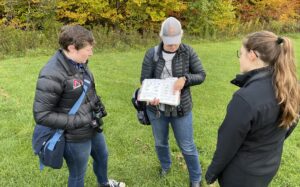
-
Bridget sharing identification tips with birders.
-
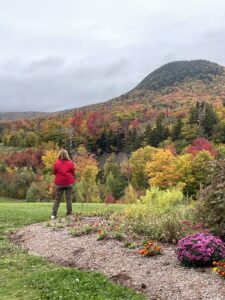
-
Varied elevations and habitats offered excellent birding.
Anyone heading for Vermont might want to join one of Bridget’s walks. If not, her slow birding technique works well anywhere. Her business is called Bird Diva Consulting. She leads bird walks, inventories birds, provides landowner assistance, and does presentations. Her website is birddiva.com.
by Winding Pathways | Sep 2, 2021 | (Sub)Urban Homesteading, Birds, Nature
A flurry of movement caught our attention. Just outside the dining room window, a tiny scrap of a bird flitted around. It wasn’t a wren, goldfinch, or sparrow. They’re around all year. Just what was it?
For most birders, May is the month to live for. Orioles, grosbeaks, tanagers, and warblers arrive as if by magic. They’re colorful, sing with gusto, and are easy to spot. It’s an exciting time, but it’s not THE ONLY exciting time.
All the colorful migrating May birds en route to northern nesting sites and the ones that stick around to nest locally are now heading south to avoid winter’s harshness. September is an outstanding birding month, but it’s also challenging.
September Birding
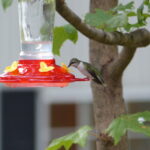
Birds stock up on high-calorie foods before their long migrations.
The birds are there but easy to miss. Many have gone through a late summer molt. They’ve replaced gaudy spring feathers with drab ones that enable them to hide better. September is a business month for birds. In May they happily court mates, but four months later the priority is beefing up their bodies for the long flight south. They dart about, often out of sight, seeking tasty insects, spiders, and seeds to fuel migration.
September birding takes patience. We find the most effective way to see birds is to sit quietly and watch. While we may slowly walk trails spotting birds in May, by September we sit on our deck in comfortable chairs, binoculars handy, and bird books and apps at the ready. We don’t find the birds. They find us, but because they don’t sing much and often look different than in Spring, identification is challenging.
Our backyard birding is exciting because we’ve diversified vegetation and have brushy areas, a prairie, a small pond, and big trees close by. However, we don’t just look there for birds. Sometimes we look upward to see soaring nighthawks, migrating raptors, and an occasional skein of Canada geese.
-
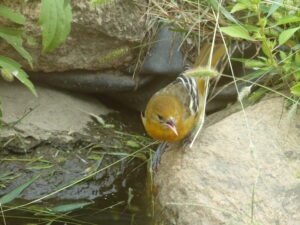
-
Birds stop for a drink and to fill up on the berries nearby.
-
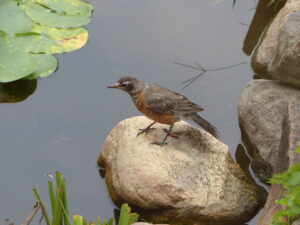
-
Keeping a wary eye, the robin cautiously gets a drink.
Identifying Fall Birds
To help with identification we use several printed bird books including the Peterson Guide and David Allen Sibley’s books. Increasingly we rely on Merlin. It’s an outstanding app produced by the Cornell University Laboratory of Ornithology. Even better, it’s free. The app easily helps identify species and shows many photos of every bird in spring/fall/juvenile/gender plumages. It also has range maps and recordings of the birds’ calls and songs. Merlin recently added a new function: sound identification. Point the phone at a singing bird and the app will help identify it by sound.
After we tentatively identify a bird, we try to confirm it by an Internet search and by consulting our birding friends. Our definitive online source is the Lab of Ornithology’s website. The site contains a vast amount of information, including how to access and use Merlin and eBird.
Easy to Keep Records
eBird allows us to record all bird species we spot in a day. Then we email results to the Lab for analysis. It’s great fun and helps the Lab research bird populations and movement.
There’s more to fall than football and leaf raking. It’s an excellent time to bird and the best birding is often the backyard.
by Winding Pathways | Jun 3, 2021 | Birds, Nature
Report from the Montessori School duck hatch: To review, the school saw a mallard sitting on an urban planter box. So, the staff and children made a project of watching the duck, noting its behavior, drawing pictures, and journaling about this experience. When the ducklings hatched the children, parents and staff followed the mother duck and ducklings on their way to new adventures.
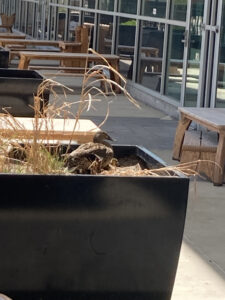
The Montessori children watched as the mallard duck sat on and hatched eggs
“The ducklings hatched last Sunday. On Monday, all 11 made it out of the planter and to the river. It was a bit traumatic. 10 fell into the storm drain and were brought out with a bug net by a parent.”
Some resources and thoughts:
The Wildlife Center of Virginia
Reconnect With Nature
Ducks Unlimited
by Marion Patterson | May 13, 2021 | Birds, Nature
In mid-April, we got a call from a concerned Montessori teacher. Her school is in downtown Cedar Rapids amid office buildings, restaurants, and taverns. Cars constantly buzz by.
She’d spotted a hen mallard duck nesting in the school’s playground and asked what she could do to help it. She knew what a great teaching opportunity this was. Children and teachers have spent the past several weeks observing and documenting the mama Mallard. They even named her – Mallory. Her partner is dubbed Howard.
Over the years we’ve fielded many similar calls from people in urban areas spotting nesting mallards and Canada geese.
For years people have heard that transforming natural areas to cities and suburbs destroys wildlife habitat. It does, at least for wildlife that shun people. However, many wild animals increase as an area urbanizes. House sparrows, rats, and pigeons come to mind, but some other beneficiaries are more welcome.
Cedar Rapids is bisected by the Cedar River, and many ducks nest downtown. Often a hen duck will nest in a large raised concrete flower pot, or as the Montessori School discovered, in the kids’ playground.
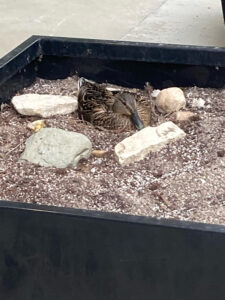
This female mallard is quite at home near the Montessori school.
Although this may seem odd, a city may be the safest nesting place. Mallards nest on the ground. Raccoons, dogs, opossums, and a slew of other predators love dining on eggs. Most duck nests out in the country get predated. All that’s left after a raccoon raid is eggshells. Fortunately, many waterfowl species renest, and usually enough nests are successful to maintain the population.
It may be that a nest in a raised concrete flower pot reduces the odds of a raccoon raid.
For many years a duck nested under a shrub near the front door of Washington High School. The hundreds of students who passed by the nest may have discouraged predators.
Canada geese also aren’t shy about people, factories, railroads, or even Interstate Highways. Many nest along Cedar Lake in an industrial area of Cedar Rapids. Normally they hide their nest, but we found one goose nesting immediately adjacent to a busy trail in plain sight.
This bird is now so numerous in many cities that they’re considered a nuisance, although we love seeing and hearing them.
So, what should someone do if they find a nesting duck or goose in a seemingly unlikely and unsafe place? The answer is simple. Just like the Montessori classes, Leave it alone, take photos, and enjoy having a beautiful and interesting animal make its home near people.
by Winding Pathways | Mar 25, 2021 | Amphibians/Reptiles, Birds, Bugs, Nature, Trees, Wonderment
Quilting and the Chesapeake Bay
Guest Blogger, Sigrid Reynolds
I have always loved the humble arts of unknown women who pieced quilts. My own attempts at the craft had resulted in exactly 10 squares in the 1980s when I had small children at home who took afternoon naps. At the same time, I started looking through the piles of quilts at antique stores in the Shenandoah Valley. It thrilled me to see the patterns, colors, and precise stitching of women from the past. So seduced was I by these piles, I knew collecting could get out of control. But then I found a Pennsylvania Dutch unquilted top in an original bold tulip design of blue, red, and yellow colors. I decided to seek and purchase only this color combination. That kept the lid on it since these colors are rare in combination.
COVID-19 Quilting
Taking up quilting again didn’t occur to me until Spring 2020 when I was asked to join a young friend’s virtual pandemic quilt circle. In a time when we all faced our own mortality and the uncertain path the pandemic and the nation would take, we needed something to calm ourselves. As a retired person, I had nothing filling my time and frankly, felt the need to leave some little part of me behind in the lives of my descendants.
The group chose a striking geometric pattern with many triangular pieces. I purchased material, cut a few triangles, and then I went rogue. My inclination was to go faster, larger and more personal since I’d found piecing tedious in those earlier tries. Besides, I am 30 years older than the members in my group so my “life” time is more limited. I found purpose in a multi-generational family vacation home on the Chesapeake Bay just begging for Aunt Sig artifacts for posterity.
A “Fishy” Quilting Inspiration
My first quilt was a re-interpretation of a fish painting that the family had owned for 90 years. The family has always asked guests to tell them how many fish they see in the painting. So, I added goldfish for a humorous twist and quilted in additional fish. In all, there are 40 fish in this quilt.
-
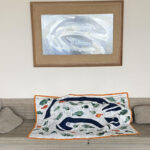
-
A humorous adaptation of the family fish painting.
-
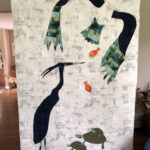
-
Remembering sunning turtles.
What came next was an urge to recognize the other birds and animals seen regularly on or near the Bay: herons in the morning and evening along with osprey all day. And then I was remembering sunning turtles in a nearby spring-fed pond. I added more goldfish and quilt fish to keep the puzzle going.
I next needed to represent the loblolly pines that line the shores of that estuary. And, of course, I needed additional visitors: raccoons, foxes, and box turtles. While quilting, I added one ghostly possum in the lower right-hand corner. And why not add some quilted poison ivy since that is always an island hazard? And yes, there are fish quilted into the water to count.
-
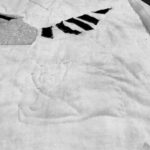
-
The beginnings of a personal quilt.
-
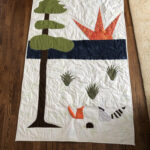
-
Capturing the sunrise
New Inspirations
Finally, as this quiet, worrisome time comes to an end, I realized that I needed to turn from nature to hail the Baltimore Light, a caisson lighthouse, that has defined the deep channel for ships going into Baltimore Harbor my entire life. Since it was winter, I recalled the two times that I had seen the Bay had frozen and decided that might be a good subject. And yes, there will be quilted fish to count under the ice floes.
Nature Continues to Inspire
I have pondered what prompts this late-in-life creativity and conclude that the pandemic opened up a fertile field in me that might have remained fallow. I, like many, turned to the nearby nature of our backyard and parks but memories of a barefoot childhood on the Bay persisted. Quilting allowed me to visit the nature of my memories.


by Winding Pathways | Mar 18, 2021 | (Sub)Urban Homesteading, Birds, Garden/Yard, Nature, Trees/Shrubs
March is a pivot month. It’s neither winter nor spring. Often called “mud season”, March is maple syruping time, but it’s also birdhouse building month at Winding Pathways.
As humans in northern climates wade through mud and long for spring, millions of birds far to the south are planning their long migration north. A few hardy waterfowl arrive as soon as the ice melts from lakes and ponds, but most birds appear, as if by magic, in April and May. We make sure our birdhouses are up before they arrive.
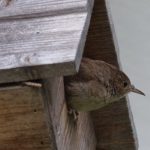
Looking out at the world.
House Wrens, Eastern Phoebes, American Robins, House Sparrows, and House Finches all nest on or near homes, barns, and garages. Although few people enjoy seeing messy House Sparrow nests tucked into nooks and crannies, most love hosting the native species as they raise the new generation outside the window.
Make Birdhouses
March is the best month to make birdhouses and restore older ones somewhat worse for the wear. Most are easy to build using simple carpentry tools. Better yet, birds aren’t fussy. Although the size of the house and the diameter of the entrance hole is important, the residents don’t care if the maker is an excellent carpenter or a novice. So, if the joints don’t fit perfectly it won’t bother birds!
Helping children make birdhouses is a fun project that involves them in nature as they learn safe tool use and basic construction techniques.
We scrounge a nearby pallet pile for free wood. Often the discarded pallets are made from boards the right width for our houses. Relatively inexpensive pine, spruce, or fir work for people who prefer to buy wood.
-
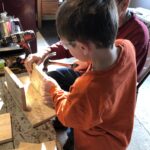
-
Working with children to make a birdhouse is rewarding.
-
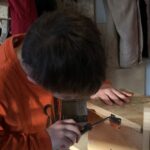
-
Children learn wood types, stages of building and how tools work.
-
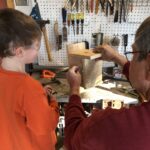
-
The birdhouse is nearly complete.
Great Resources to Guide Your Work
The best information source for virtually anything about wild birds is the Cornell University Laboratory of Ornithology. Their website gives great information on many aspects of birds, including what species likely live in an area. The site is complex but fascinating. A second website, also by the Lab, is more specific to birdhouses and nesting. The Laboratory of Ornithology site helps anyone predict what birds might migrate to their yard and when they’ll arrive. It also includes plans on how to build birdhouses. There’s even a video showing construction tips.
There’s more to birdhouses than just making one. They must be erected in the right place and height above the ground. The Lab’s website provides the right information. And, here are two tips from Winding Pathways.
Tips from Winding Pathways
- Many birdhouse plans to use nails as a hinge so the house can be opened for cleaning. We buy and use small hinges, hooks, and eyes to make opening the box to clean it easier.
- It’s tempting to attach a birdhouse to a tree using a nail or screw. That may work but eventually, the birdhouse falls off. But, the metal remains embedded in the tree. This creates danger as the tree grows around the metal, hiding it. Hitting a nail with a chainsaw is downright scary and dangerous. Also, driving a nail into a live tree can introduce diseases that could kill it. We use wire or rope to attach our birdhouses to live trees and use screws to attach birdhouses to nonliving posts and poles. One of our wren houses is suspended from a hook screwed into our porch ceiling.
Building birdhouses and enjoying a wren couple raises a brood is a fun family activity that we never tire of.
















